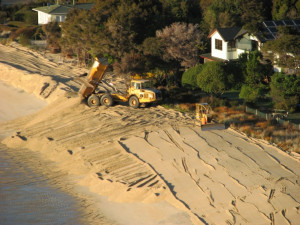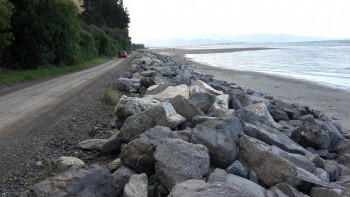The 'protect' grouping is a set of options that ‘hold the line’ and protect coastal areas from the sea. Options include soft protection and hard protection.
Soft protection such as dune and beach nourishment/replenishment (e.g. sand push-ups) and wetland restoration and enhancement can assist in reducing the impacts of natural hazards on coastal development while protecting a number of other values including cultural, coastal habitats and species, landscapes, public access and recreation. Sand push-ups are designed to provide a sacrificial barrier of sand which is eroded away during storms, protecting property on the landward side from erosion. Following large storm events, sand push-ups can be undertaken again to reinstate the sand.
Hard protection includes hard structural measures such as coastal protection structures (sea walls), groynes, stopbanks, tide banks, and causeways. Hard protection measures modify natural coastal processes on beaches and nearshore coastal land. Their purpose is to deter or prevent coastal erosion or seawater inundation affecting those coastal areas they are built to protect (e.g. development and/or coastal land uses) over the short to medium term. However, they tend to shift these issues to other parts of the coast and this needs to be considered in their suitability as an option. The location and design of hard protection may result in the degradation of the environmental, cultural, access and recreational values of beaches and coastal areas. Their use can also result in unintended outcomes such as ‘end wall effects’ for sea walls affecting adjacent properties, and liability issues.
The use of soft and/or hard protection signals that there will be investment to protect an area for longer, at least as an initial part of a longer-term strategy, recognising there will likely be a need for retreat or enhanced or alternative protection at some point in the future. For hard protection, costs will vary depending on location and design, but they are expensive to build and maintain. The use of hard protection may be counterproductive, as they will only delay damage, and may encourage further intensification of development in vulnerable coastal areas.
The New Zealand Coastal Policy Statement 2010(external link) discourages the use of hard protection structures (Policy 25) and promotes the use of alternatives including natural defences/soft protection (Policy 26). In relation to protecting significant existing development from coastal risks, Policy 27 prefers strategies that reduce the need for hard protection structures and similar engineering interventions.
Two case studies of soft and hard protection from within our District are set out below, and there are other case studies listed in the Coastal Management Options report (above), including Council’s coastal protection policies.
Download the (pdf 61 KB)Protect option summary poster.
 Soft protection shoreline management is successfully undertaken at a number of locations in the District through sand push-ups and plantings/Coastcare projects. In recent years, resource consents for sand push-ups have been granted in areas such as Pakawau, Torrent Bay, and Little Kaiteriteri in response to coastal erosion.
Soft protection shoreline management is successfully undertaken at a number of locations in the District through sand push-ups and plantings/Coastcare projects. In recent years, resource consents for sand push-ups have been granted in areas such as Pakawau, Torrent Bay, and Little Kaiteriteri in response to coastal erosion.
Torrent Bay beach within the Abel Tasman National Park experiences periodic erosion as a result of storms and ongoing wave action. The erosion may impact on the back-beach dune planting, public access routes, and ultimately private property. The Council periodically replenishes the beach from the lower foreshore to the upper foreshore. Beach replenishment work is usually undertaken every 2-3 years on average, depending on the frequency of storm events. This activity has been undertaken since 2005 and has helped to mitigate erosion issues to date. These sand push-ups are funded through a mix of targeted rates on Torrent Bay landowners and wider Council funding.
 Along the Tasman Bay/Te Tai o Aorere and Golden Bay/Mohua coastline, there are a number of hard protection structures built on both public and private property to protect land, buildings and/or community assets (roads, parks and reserves, etc.) from coastal erosion and/or inundation from present day high tides. Council-owned hard protection structures were historically built to mitigate coastal erosion only (not inundation). Locations of protection structures include coastal urban areas (e.g. Ruby Bay, Mārahau, Collingwood), and both farmland and industrial land adjacent to the Waimea Inlet, coastal farmland near Riwaka, and coastal farmland at Ferntown (near Collingwood). These structures are built from a variety of materials. At some low-lying rural locations, behind tide banks and areas where drainage is compromised by high tide levels, pumps are also used to control or reduce water levels.
Along the Tasman Bay/Te Tai o Aorere and Golden Bay/Mohua coastline, there are a number of hard protection structures built on both public and private property to protect land, buildings and/or community assets (roads, parks and reserves, etc.) from coastal erosion and/or inundation from present day high tides. Council-owned hard protection structures were historically built to mitigate coastal erosion only (not inundation). Locations of protection structures include coastal urban areas (e.g. Ruby Bay, Mārahau, Collingwood), and both farmland and industrial land adjacent to the Waimea Inlet, coastal farmland near Riwaka, and coastal farmland at Ferntown (near Collingwood). These structures are built from a variety of materials. At some low-lying rural locations, behind tide banks and areas where drainage is compromised by high tide levels, pumps are also used to control or reduce water levels.
Both Council-owned and privately owned hard protection structures that have resource consents often allow maintenance to occur as required. However, their presence is uncertain beyond the consent expiry date. There are some privately erected structures along the coastline that do not have formal authorisation and similarly, there is no certainty that they will continue to function in a protective capacity into the future. General issues such as the removal of structures when they are no longer working and who pays (end of life costs) will become more problematic as sea levels rise.